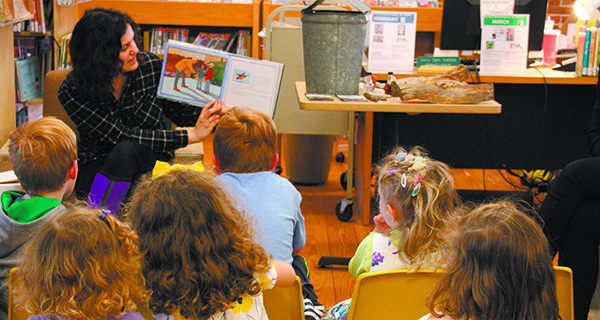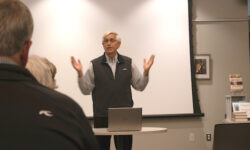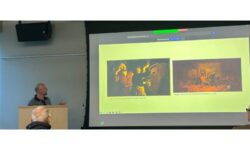[ccfic caption-text format="plaintext"]
By Laura Drinan
Hometown Weekly Reporter
Pancakes, waffles, and French toast just wouldn’t be complete without a drizzle of maple syrup over them. The sticky, sweet syrup is an American favorite – especially at breakfast time – and only contains one simple ingredient: sap from a maple tree.
The process of making it, however, is a bit more difficult.
Farmer Anna from Land Sake’s Farm visited the Sherborn Library on February 28 for a maple syrup-inspired storytime - and to give children the chance to hold common tools used to tap maple trees.
As children shuffled into the library and found their seats, Anna introduced the first book she would read: Marsha Chall’s “Sugarbush Spring.” The book details the maple sugaring process from the perspectives of two children helping their grandfather tap the trees.
The next book, Nan Rossiter’s “Sugar on Snow,” told the story of a New England family who collects sap to boil into maple syrup. As she read, Anna occasionally paused to tell the children how Land Sake’s processes differ from those in the stories.
With a better understanding of the process of maple sugaring, the children were eager to learn more about the maple sugaring tools that sat on the table next to Anna.
She described the farm’s methods of finding a tree to tap and showed the children how they hug the trees to measure if they’re large enough to give sap. Then Anna held up a hand drill before showing the children three different spiles - that is, small pegs that the sap flows out of.
She told the children about how the Native Americans first made maple syrup using a wooden spile, and compared the large peg to the contemporary small metal peg.
A large, galvanized bucket with a triangular slit also sat on the table next to Anna. She demonstrated how they would hang the bucket on a tree to make sure all of the sap fell into the bucket.
She held up the last two items on the table side-by-side to show the children the different between the bottles of clear sap and the amber-colored maple syrup, surprising the children when she said it takes 40 gallons of sap to make one gallon of syrup.
To end the program, Anna set a piece of wood on the floor and gave each child a turn to make a hole in it using the hand drill.
After learning so much about maple syrup, the children left the library to excitedly to go into their own backyards and look for maple trees to tap.






















